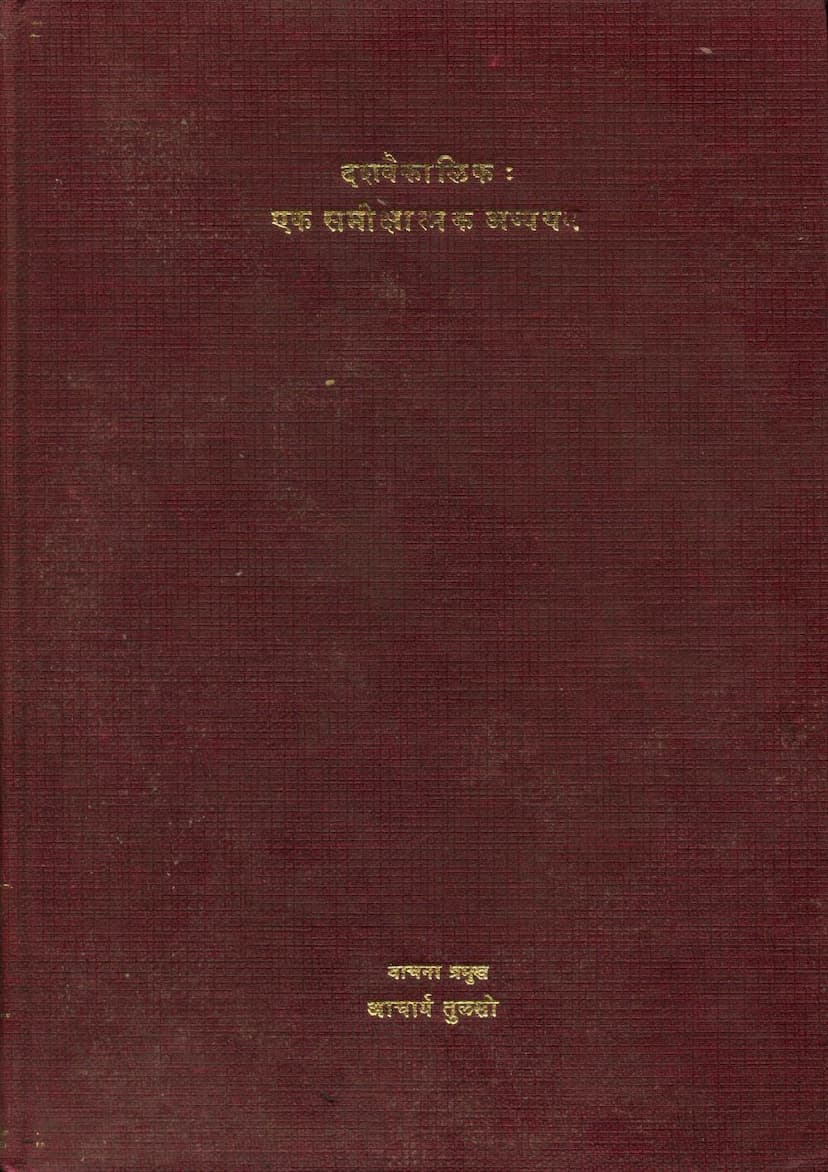Dashvaikalik Ek Samikshatmak Adhyayan
Added to library: September 1, 2025

Summary
This document is a comprehensive scholarly study titled "Dashvaikalik: Ek Samikshatmak Adhyayan" (The Daśavaikālika Sūtra: A Critical Study). Authored by Acharya Tulsi and Muni Nathmal, and published by the Jain Shwetambar Terapanthi Mahasabha, this book is the first in their "Agam-Anushilan Granth-Mala" (Canon Study Book Series).
The study undertakes an in-depth examination of the Daśavaikālika Sūtra, a significant text within Jain Jainism. It meticulously analyzes the sutra from various perspectives, aiming to provide a critical understanding for both scholars and the general public.
Key aspects covered in the study include:
-
Introduction and Dedication: The book begins with a dedication and expressions of gratitude.
-
Publishers' and Editors' Notes: These sections provide context for the publication and the authors' intentions.
-
Structure of the Book: The book is structured into six main sections, with an appendix. The main sections are:
- Bahirang Parichay (External Introduction): This section provides an overview of the Jain Agamas and specifically the Daśavaikālika Sūtra. It covers:
- Definition of Agamas and the position of Daśavaikālika within the classification.
- The naming and utility of the sutra.
- The author and period of composition.
- The style of composition.
- Grammatical aspects, including sandhi, case, number, compound words, suffixes, gender, verbs, adverbs, and specific usages.
- Linguistic analysis.
- Discussion of the sutra's structure.
- Metrical analysis.
- Use of similes and metaphors.
- Definitions of terms.
- Chulikas (supplementary sections) associated with the sutra.
- Comparison with Ācārāṅga Chūlikā.
- Influence of Daśavaikālika on later literature.
- Comparative analysis with Buddhist and Vedic traditions.
- Antarang Parichay (Internal Introduction): This section delves into the core philosophical and practical teachings of the Daśavaikālika Sūtra, focusing on:
- The overall spiritual perspective of the sutra.
- The components of spiritual practice, including Ahimsā (non-violence), the perspective on maintaining a disciplined life, the reverence for teachings, and endurance of hardships.
- The importance of Vinaya (discipline/respect).
- The path to spiritual excellence.
- Mahavrata (Great Vows): This detailed chapter explores the five great vows central to Jain practice:
- Classification of living beings.
- Concise explanations of Ahimsā, Satya (truthfulness), Achaurya (non-stealing), Brahmacharya (celibacy), and Aparigraha (non-possession).
- Specific guidance on Ahimsā in relation to different types of living beings (earth-bodied, water-bodied, fire-bodied, air-bodied, plant-bodied, and mobile beings).
- Charya-Path (Code of Conduct): This section outlines the practical guidelines for ascetics as described in the sutra, covering:
- Movement and wandering (Charya and Vihara).
- Control of natural urges (Vego-nirodha).
- Ethical conduct in walking, sitting, and standing (Iryapatha).
- Purity of speech (Vak-Shuddhi).
- Principles of alms-seeking (Eshana), including its purpose, method of collection, and consumption.
- Control of senses and mind (Indriya and Mano-nigraha).
- Achieving steadiness in practice (Sthirikaran).
- The purpose behind these practices (Kis liye?).
- The importance of Vinaya (discipline).
- Criteria for identifying the worthy (Pujya).
- The definition of a mendicant (Bhikshu).
- Qualities of a mendicant (Muni ke visheshan).
- The gradual path to liberation (Moksha ka kram).
- Vyakhyā-Granthon ke Sandarbh mein (In the Context of Commentaries): This extensive section analyzes the various commentary traditions and their contributions to understanding the Daśavaikālika Sūtra. It includes:
- An introduction to the commentary literature.
- Discussion of ancient commentary traditions.
- Detailed analysis of the process of alms-seeking (Āhāra-charyā).
- The ideal conduct and characteristics of a mendicant (Muni kaisa ho?).
- The methodology of "Nakshep" (categories of analysis).
- The philosophical concepts of Dharma (duty/righteousness).
- Understanding Apaya (relinquishment) and Upaya (means) through Nakshep.
- The significance of Niruḳta (etymology) in understanding the text.
- Exploration of Ekārthaka (synonyms) words.
- Analysis of the sutra's impact on later literature and its comparison with other traditions.
- A detailed comparative study with Buddhist and Vedic texts.
- Niruḳta (Etymology): This chapter focuses on the etymological explanations of key terms within the sutra, aiding in a deeper semantic understanding.
- Eka-artha (Synonyms): This section lists and explains synonymous terms used in the sutra and its commentaries, highlighting the richness of the language.
- Sabhyata aur Sanskriti (Civilization and Culture): This section draws insights into the socio-cultural context of ancient India as reflected in the sutra and its commentaries, covering aspects like:
- Description of various types of dwellings (Griha).
- The use of implements (Upakaran).
- The concept of duty and tradition (Kartavya aur Parampara).
- Trade and travel (Vyapar Yatra).
- The nature of books (Pustak).
- Metal usage (Dhatu).
- The position of humans (Manushya ka sthan).
- The system of justice and punishment (Dand Vidhi).
- Education (Shiksha).
- Addressing people (Sambodhan) with various customary terms of address.
- Royal administration and provincial governance (Rajya Vyavastha, Janpad).
- Weapons (Shastra).
- The practice of begging and charity (Yachana aur Dan).
- The concept of sustenance (Bhoj).
- Belief systems (Vishwas).
- Health and medicine (Rog aur Chikitsa).
- Worship (Upasana).
- The significance of sacrifices (Yajna).
- The classification of languages (Bhasha).
- The structure of the sutra (Sharir-paramarsh).
- The metrical patterns used (Chhand-vimarsh).
- The use of analogies and examples (Upama aur Drishtant).
- The nature of Chulikas (supplementary sections).
- The relationship and comparison with the Chulikas of the Ācārāṅga Sūtra.
- The influence on subsequent literature.
- A comparative analysis with Buddhist and Vedic literature.
- Bahirang Parichay (External Introduction): This section provides an overview of the Jain Agamas and specifically the Daśavaikālika Sūtra. It covers:
-
Appendix:
- Churni ki Paribhashayein (Definitions from Churnis): This appendix provides definitions of various terms as found in the Churnis (commentaries).
- Prayukta Granth-Soochi (List of Used Texts): A comprehensive bibliography of the texts consulted during the preparation of this study.
The book aims to provide a scholarly and critical analysis of the Daśavaikalika Sūtra, making its rich teachings accessible to a wider audience while also engaging with the complex layers of Jain scriptural tradition and commentary.